|
|
See interactive version
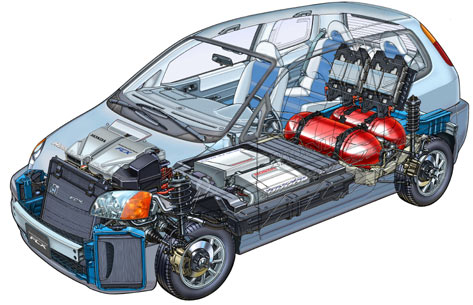
 |
 |
 |
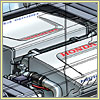

| |
Fuel Cell Stacks
This is the heart of the hydrogen fuel cell car—the fuel cell stacks.
Their maximum output is 86 kilowatts, or about 107 HP. Because hydrogen fuel cell stacks produce
power without combustion, they can be up to twice as efficient as internal
combustion engines. They also produce zero carbon dioxide and other pollutants.
For more information on the stacks, see How Fuel Cells Work.
|
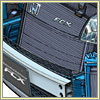

| |
Fuel Cell Cooling System
This has several parts. Perched at an angle at the front of the vehicle is a
large radiator for the fuel cell system, while two radiators for the motor and
transmission lie ahead of the front wheels below the headlights. The car also
has a cooling pump located near the fuel cell stacks to stabilize temperature within
the stacks.
|
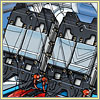

| |
Ultracapacitor
This unit serves as a supplementary power source to the fuel cell stack. Like a
large battery, the ultracapacitor recovers and stores energy generated during
deceleration and braking. It uses this energy to provide a "power assist"
during startup and acceleration.
|
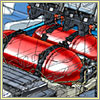

| |
Hydrogen Tanks
Space in a car is limited, yet hydrogen
is the most dispersive element in the universe and normally requires lots of
room. A challenge for manufacturers is how to compress the gas into tanks small
enough to fit in a compact car and yet still provide enough fuel for hundreds
of miles of driving between refuelings. The two high-pressure hydrogen tanks in
this vehicle can hold up to 3.75 kilograms of hydrogen compressed to roughly 5,000
PSI—enough to enable an EPA-rated 190 miles of driving before
refueling, the manufacturer says.
|
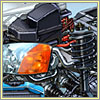

| |
Electric Motor
(General area only—motor not visible) The electric motor offers a maximum
output of 80 kilowatts, enabling a top speed of about 93 miles per hour. The
manufacturer says this vehicle can also start in subfreezing temperatures (down
to about -4°F), a perennial problem in fuel cell prototypes. Being
electric, the engine and the car as a whole are quiet, with none of the
vibration or exhaust noise of a gas-powered automobile.
|


| |
Air Pump
(General area only—air pump not visible) Run by a high-voltage electric
motor, this pump supplies air at the appropriate pressure and flow rate to the
fuel cell stacks. The air, in turn, mixes with the stored hydrogen to create electricity.
|
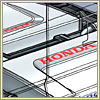

| |
Humidifier
The humidifier monitors and maintains the level of humidity that the fuel cell stack needs to achieve peak operating efficiency. It does this by recovering some of the water from the electrochemical reaction that occurs within the fuel cell stack and recycling it for use in humidification.
|


| |
Power Control Unit
(General area only—power control unit not visible) This controls the
vehicle's electrical systems, including the air and cooling pumps as well as
output from the fuel cell stacks, electric motor, and ultracapacitor.
|
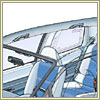

| |
Cabin
With the fuel cell stacks hidden beneath the floor and the hydrogen tanks and
the ultracapacitor beneath and behind the rear seats, respectively, the
four-passenger cabin is isolated from all hydrogen and high-voltage lines.
Hydrogen gas is colorless and odorless, and it burns almost invisibly. In case
of a leak, therefore, the manufacturer has placed hydrogen sensors throughout
the vehicle to provide warning and automatic gas shut-off. Also, in the event
of a collision, the electrical source power line shuts down.
|


| |
Hydrogen Filler Mouth
(Not visible—located on other side of vehicle) Drivers would fill the car
with hydrogen just as they do with gasoline, through an opening on the side of
the vehicle. The main difference is that a fuel cell car must be grounded
before fueling to rid the car of hazardous static electricity. For this reason,
this model has two side-by-side openings, with the latch to open the hydrogen
filler mouth located inside the opening for the grounding wire. The
manufacturer says filling up this model's two tanks at a hydrogen filling
station would take about three minutes.
|
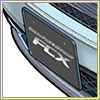

| |
Note
The limited-production vehicle seen in this feature is a Honda 2005 FCX, which is
typical of the kinds of hydrogen fuel cell automobiles that some major
automakers are now researching and developing. With such vehicles at present
costing about $1 million apiece, none is currently for sale, though hundreds of
fuel cell cars are now undergoing tests on the world's roads.

|
|
|
|
|
|
|




